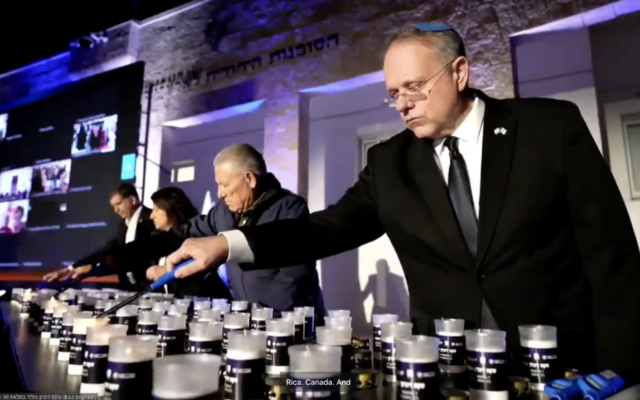A traditional milestone of mourning
30 days after Oct. 7, a Jewish world wracked by grief is marking a traditional milestone of mourning.

(JTA) A wide array of events and experiences are planned to mark the 30-day threshold since the Oct. 7 massacre that killed 1,400 Israelis — even though many of their loved ones have yet to reach that point in the Jewish grieving process.
The 30-day mark after death is a meaningful moment in the Jewish calendar of grief. It is when a secondary period of ritual mourning – following shiva, which lasts for seven days beginning with burial — is lifted for anyone who has lost a spouse, sibling or child. (People who have lost a parent mourn for a whole year.)
During the period, known as shloshim, mourners are prohibited from some activities, such as cutting their hair, listening to music, and attending religious celebrations and social events, but they are permitted to resume many personal and professional activities. The idea, according to the tradition, is to help mourners ease back into their communities.
“Judaism acknowledges that grief isn’t linear, and shloshim is really part of that framework,” said Sarit Wishnevski, head of Kavod v’Nichum, a nonprofit that supports progressive and pluralistic Jewish burial societies in North America. “Tradition gives us a roadmap about how to proceed at a time when there is no clear path forward.”
The 30-day mark after death is a meaningful moment in the Jewish calendar of grief. It is when a secondary period of ritual mourning – following shiva, which lasts for seven days beginning with burial — is lifted for anyone who has lost a spouse, sibling or child. (People who have lost a parent mourn for a whole year.)
During the period, known as shloshim, mourners are prohibited from some activities, such as cutting their hair, listening to music, and attending religious celebrations and social events, but they are permitted to resume many personal and professional activities. The idea, according to the tradition, is to help mourners ease back into their communities.
“Judaism acknowledges that grief isn’t linear, and shloshim is really part of that framework,” said Sarit Wishnevski, head of Kavod v’Nichum, a nonprofit that supports progressive and pluralistic Jewish burial societies in North America. “Tradition gives us a roadmap about how to proceed at a time when there is no clear path forward.”
Some Jews have taken on the mourning rituals of the shloshim period despite not being obligated to under Jewish law, in part because at least some of the people killed on Oct. 7 left behind no one to mourn for them.
“My wife Tami and I decided, when we learned how many of the dead from the October 7th attack were complete families and therefore wouldn’t have a kaddishel (someone obligated to say kaddish for them), we vowed that we would observe shloshim for them,” Rabbi Jeffrey Arnowitz of Westchester Jewish Center said in a blog post about his trip to Israel last week, in which he and other Conservative rabbis from the United States were the first civilian group to visit Kibbutz Be’eri, where more than a quarter of residents were killed or abducted.
“If you’ve noticed me looking a bit scruffy lately, that’s why,” Arnowitz wrote. “The truth is I have been grieving like a mourner and the ritual has helped me move through the last four weeks as I get used to a world that looks and feels different than it did on October 6th.”
Marking shloshim does not take away from the pain that is deeply felt across the Jewish world right now, said Wishnevski, whose own cousin’s husband, Sagui Dekel-Chen, disappeared from his kibbutz on Oct. 7 and is thought to be held hostage in Gaza.
“We need to be able to continue living our lives and being with our families and doing our work and being in the world,” she said. “We’re not forgetting. We’re not leaving anything behind. But we’re marking time together.”

comments